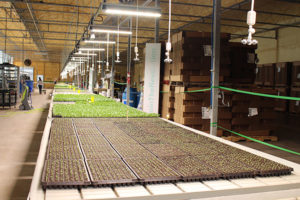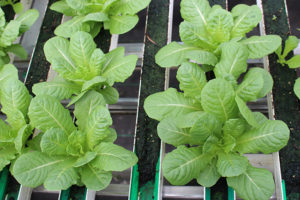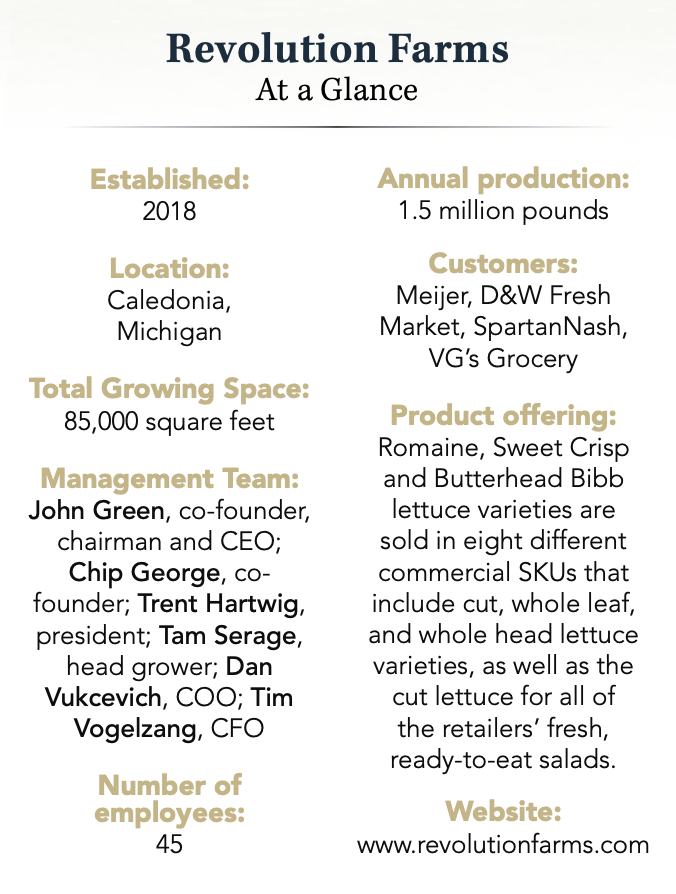
Cover Story — Greens From the Greenhouse
It was just a few years ago that co-founders John Green and Chip George had an idea to build a greenhouse in Caledonia, Michigan, to hydroponically farm lettuce and other leafy greens.
Dynamic decisions and added investments have paved the way to its current success. An early strategy to have tanks of fish excrete natural fertilizer for the produce farm (aquaponics) had to be adjusted. Today, the fertilizer is mixed in the tanks without fish. A greenhouse addition in 2021 was built with a more highly automated setup. Four years after launching a lettuce farm outside Grand Rapids, Michigan, Revolution Farms has made inroads with large regional retailers.
THE PEOPLE

Revolution Farms CEO John Green is involved with many companies in West Michigan — perhaps the most well-known is the Founders Brewing Co., of which he served as executive chairman for more than a decade. In addition to Revolution Farms and Founders, Green also keeps up roles with Libby Wines and Cirkul, a flavored water company.
“We launched Revolution Farms to change the world by changing the way we grow food. Our revolution begins at home, by growing closer to where we live, more sustainably, with less water and land, and figuring out how to accomplish this in Michigan all year long,” Green says.
Head grower Tammam “Tam” Serage in late 2019 came to Revolution Farms from Shenandoah Growers in Harrisonburg, Virginia. A career grower, Tam has more than 25 years of practical experience in production of organic herbs, microgreens and ornamentals. He’s worked as head grower at farms in Maryland and Delaware, as well as roles at farms in Alabama and Saudi Arabia, and holds bachelor’s and master’s degrees in horticulture from Virginia Tech.

Serage’s hydroponics experience has come in handy as the company expanded its greenhouses in 2021. Much of the farm is now automated, which both reduces human contact with the food (thus reducing food safety concerns) and also minimizes the company’s labor needs. At the new greenhouse, just one employee runs the seeding equipment, another runs the harvesting equipment, and the plants and product are completely untouched by human hands until they reach the cool packing room, where the majority of the company’s 45 employees work.
“No. 1 for us is to have a grower-first mindset,” says Trent Hartwig, president of Revolution Farms. “(Serage) is able to train a lot of people. No. 2 is to be nimble and flexible.”

Hartwig, who has been with Revolution Farms for nearly a year, came to the company with experience selling to big-box retailers. He is an advocate for what the produce industry calls consumer education — telling the story of exactly how their fruits and vegetables are being grown; in this case, hydroponically and in the Midwest, harvested just a day or two before hitting store shelves.
“The retailers are opening up their stores for consumer education,” he says. Promotional opportunities are available at grocery stores, who favor growers who can produce consistently year-round.
“We’ve been able to demonstrate that,” Hartwig says. “That’s a huge part of why we’ve been able to earn the Meijer business.”
While Revolution Farms’ greens are in several different chains of stores, the operation in early summer celebrated a milestone in its relationship with Meijer, a chain of 262 stores in the Midwest that’s based in Grand Rapids.
THE PROCESS
The leafy greens are grown out to harvest in 28 days.
In the original, older portion of the greenhouse, floating mats are planted with seedlings that are hand-seeded and propagated on a bench. The roots reach down into the water to gather the nutrient- rich water. On a morning in June, much of the greenhouse was drained for a deep cleaning that’s conducted every two years — a necessary delay.
“It’s a rip-the-Band-Aid-off, get-it-done solution,” Hartwig says of the cleaning.

The newer section is a more highly automated mobile gutter system (MGS) planted with a vacuum-assisted seeding machine from Finland’s Green Automation. The automated planter packs peat growing media (from BFG Canada) into the gutters before seeding each gutter with 110 seeds — the system can handle either raw or pelletized seeds.
“It’s so versatile,” Serage says. “Once the gutter leaves, it has a destination … We can track them all the way through.”
The gutters are moved in and out of the new greenhouse by conveyor belt. Each gutter has a number and the climate controlled data from the greenhouse is pulled regularly. Plants in the gutters are fed using nutrient film techniques (NFT). Both greenhouses are lit with LEDs that include Fluence’s VYPR series of lighting. Cooling fans keep the temperatures homogeneous and help avoiding tip burn on the leaves, by ensuring the plants continue to transpire and uptake nutrients.
Both the seeding and harvesting facilities run parallel to the sides of the new greenhouse, so upon entering and leaving the greenhouse, the gutters are robotically turned 90 degrees — like a hand on a clock — to line up with the seeding and harvesting facilities.
At the harvesting line, the heads of lettuce are chopped off as the gutter moves through the processing machine. The lettuce stumps, with peat, go to a local farmer who feeds them to pigs.

The leafy greens are carried into the cooled packhouse by a food-safe cloth belt that weighs the harvest.
“Usually every week, we download the data,” Serage says. “That’s how we test varieties.”
For best results, Revolution Farms has also collaborated with top seed-breeding companies, with representatives from Enza Zaden and Nunhems, a seed brand of BASF.
THE PRODUCT
The different production lines allow a variety of branded products. Revolution Farms sells cut, whole leaf and whole head lettuce varieties, as well as the cut lettuce for ready-to-eat salad kits.
Revolution Farms packages the greens in eight different SKUs. Meijer customers can find Revolution Farms branded products on shelves under three new, whole-leaf lettuce varieties — Revolution Farms Lettuce Boats, Revolution Farms Whole Leaf Romaine, and Revolution Farms Sweet Crisp Deli Leaf. Whole head items — Revolution Farms Whole Head Living Bibb and Revolution Farms Whole Head Living Sweet Crisp — are also available at all Meijer stores.
“Supporting local farms and carrying the freshest, most nutritious ingredients
is important to us and to our customers,” Meijer produce buyer Sarah Jennings said in a news release. “As a Michigan, family company, we are committed to being good stewards of our community by not only constantly enhancing our own sustainable practices, but also by using our shelves as a platform to promote brands that share our passion.”
Startup, controlled-environment- agriculture operations like Revolution Farms, and its peers and competitors in the Midwest and Northeast, are a relatively young force in the produce markets, and their practices and business models continue to evolve.
While spinach is highly sought after by consumers, Hartwig said that it has been difficult to grow for many hydroponics farming operations and is likely still a few years away being grown by most hydroponic growers. Also, many small hydroponic farms remain independent of each other.
“I think you’ll start to see some consolidation in the industry,” he says.
But for now, Revolution Farms continues to educate consumers about the value of locally grown, hydroponic greens, ramp up production and land clients like Meijer. Consumer education is one of the reasons it continues to open their farm.
“We don’t shy away from having visitors,” Hartwig says.
Stephen Kloosterman is the Managing Editor of Greenhouse Product News.










 Video Library
Video Library 


















